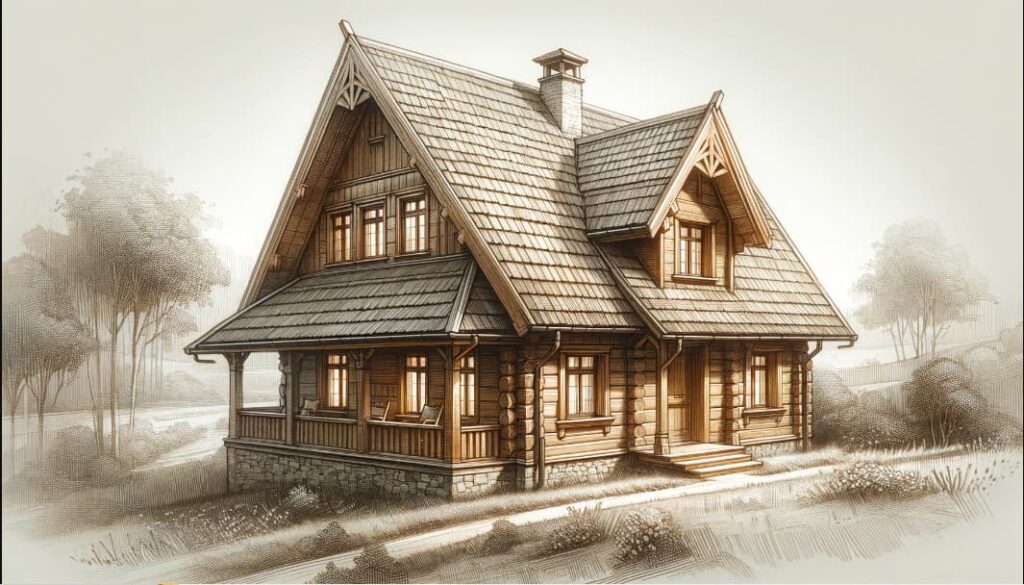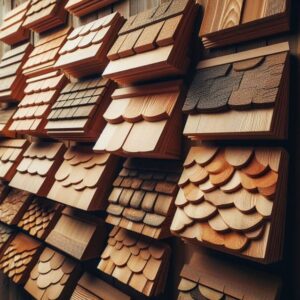Roofing
Wood Roofing Guide: Elegance & Durability
In the realm of roofing, the quest for both elegance and functionality often leads homeowners to one timeless choice: wood roofing.
With its rich history, distinctive appeal, and insulating properties, wood roofing stands out as a premier option for those aiming to blend aesthetic beauty with practical benefits.
Whether you’re renovating a classic home or building a new one with a nod to traditional aesthetics, understanding the nuances of wood roofing is essential.
The Rich History of Wood Roofing
Wood roofing’s journey from the rugged shelters of the 17th century to the sophisticated homes of today is a testament to its enduring appeal.
Originating as a necessity, it has evolved into a choice that symbolizes both luxury and sustainability. For a deeper dive into its fascinating evolution.
Understanding Wood Roofs: Shingles vs. Shakes
Choosing between wood shingles and shakes is the first step in tailoring your roof to your home’s style and your personal preferences.
Wood shingles are machine-sawn and known for their uniform appearance, making them a fit for modern and traditional homes alike.
Wood shakes, on the other hand, are hand-split, offering a more rustic, textured look with enhanced durability against the elements. For homeowners looking to make an informed choice, this comparison tool can help.
Types of Wood Roofs
From the weather-resistant cedar to the elegant teak, each type of wood roof has its own set of benefits:
- Cedar Shingles and Shakes: Known for their durability and resistance to rot.
- Teak Shingles: Highly resistant to moisture and pests, making them ideal for humid climates.
- Pine Shakes: Offer a lighter aesthetic with excellent insulation properties.
- Redwood Shingles: Prized for their natural beauty and longevity.
For those interested in exploring these materials further, here’s where you can find quality suppliers.
Advantages of Choosing a Wood Roof
The advantages of wood roofing extend beyond its visual appeal. Its natural insulating properties can help reduce energy costs, while its renewable nature makes it an eco-friendly choice. For inspiration, check out this gallery of stunning wood roof installations.
Key Considerations and Drawbacks
While wood roofs add undeniable charm, they require maintenance to preserve their beauty and functionality. From treating against rot and algae to managing the flammability risks, homeowners should be prepared for the upkeep.
For those considering a wood roof, protective treatments and services can be found here.
Modern Alternatives to Wood Roofing: Metal and Beyond
For homeowners seeking the look of wood without the maintenance, metal roofing, especially stone-coated steel options like DECRA, offers an appealing alternative.
These products combine the durability of metal with the aesthetic of traditional wood. To compare wood and metal roofing options, visit this page.
Maintenance Tips for Wood Roofs
Regular inspections and timely maintenance are key to extending the life of your wood roof. From applying UV protective sealants to ensuring proper ventilation, the care you put into your roof will reflect its longevity and performance.
For the best products and tips on wood roof upkeep, explore these recommended resources.
Choosing the Right Wood Roofing for Your Home
Selecting the right wood roofing involves considering various factors, including your home’s architectural style, the local climate, and your long-term living plans.
For personalized advice and to match with the best roofing solutions for your home, consult with a roofing expert here.
Conclusion
Wood roofing, with its blend of aesthetic beauty and natural insulation, offers a timeless roofing solution that appeals to homeowners valuing tradition and sustainability.
As you consider wood roofing for your home, remember that the choice involves balancing the allure of wood with the realities of its maintenance and care. W
hether you opt for the rustic charm of shakes or the sleek appearance of shingles, wood roofing can transform your home into a testament to enduring elegance. Before making your final decision, why not explore the possibilities with a professional consultation?
Are you ready to elevate the beauty and value of your home with wood roofing?
Frequently Asked Questions
1. What are wood roofs called?
A. Wood roofs are commonly referred to as “wood shingle roofs” or “wood shake roofs,” depending on the specific style of wood roofing material used.
Shingles are machine-cut and have a more uniform, smooth appearance, while shakes are hand-split, giving them a rougher, more textured look.
2. What type of wood is best for roofing?
A. The best type of wood for roofing often depends on the climate and specific needs of the homeowner, but cedar is one of the most popular and widely recommended options due to its durability, resistance to rot, and natural insect-repelling properties.
Other commonly used woods include redwood, teak, and pine, each offering unique benefits like moisture resistance (teak) or aesthetic appeal (redwood).
3. What are the cons of a wood roof?
A. The cons of a wood roof include:
- Maintenance Requirements: Wood roofs require regular maintenance, including cleaning, treating for mold and mildew, and sometimes re-sealing to maintain their appearance and durability.
- Cost: Wood roofing materials are often more expensive than alternatives like asphalt shingles, both in terms of materials and installation.
- Flammability: Wood is naturally flammable, which can be a concern in areas prone to wildfires. Though treatments can improve fire resistance, it remains an inherent risk.
- Susceptibility to Weather Damage: Wood can be vulnerable to splitting, warping, or rotting due to exposure to moisture and extreme weather conditions if not properly maintained.
4. Wood Shake Roof vs Shingles
A. The main difference between wood shakes and shingles lies in their appearance and production. Shakes are split from logs, giving them a more rustic, textured look, while shingles are sawn for a smoother finish.
Shakes tend to be thicker and more durable than shingles but require more maintenance to preserve their appearance.
5. Roof Wood Planks
A. Roof wood planks, or decking, form the base layer of the roof to which shingles or shakes are attached. These planks provide structural support and are typically made from plywood, OSB (oriented strand board), or solid wood.
The choice of material can impact the roof’s durability and overall performance.
6. Roof Wood Panels
A. Roof wood panels are an alternative to traditional planks and can be used as a base for roofing materials.
These panels are often made from engineered wood and offer a uniform, stable surface for roofing.
They can provide improved insulation and are quicker to install than individual planks, making them a popular choice for modern construction.
Recent Posts
- Flat Roof – Decoding: Installation, Maintenance, and Materials
- Black Metal Roofing : The Comprehensive Guide
- What Are the Best Roofing Shingles for Your Home?
- Rubber Roof Repair – A Comprehensive Guide


